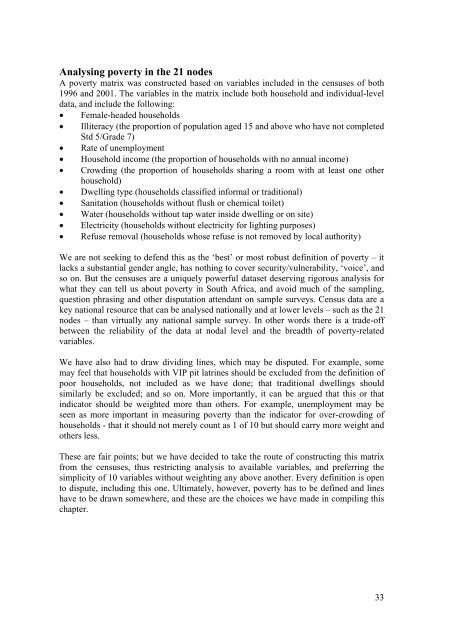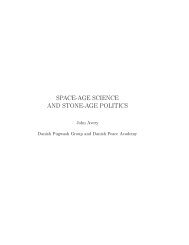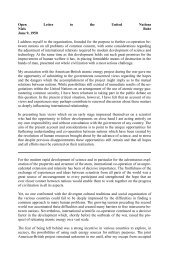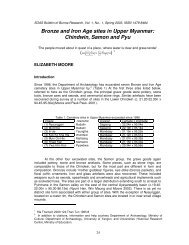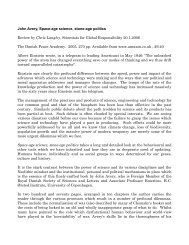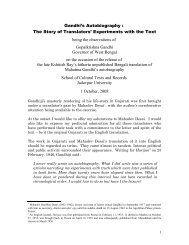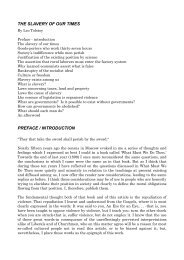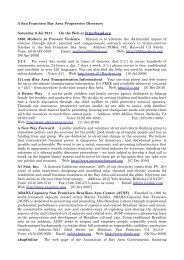History in the new South Africa: an introduction - Det danske ...
History in the new South Africa: an introduction - Det danske ...
History in the new South Africa: an introduction - Det danske ...
Create successful ePaper yourself
Turn your PDF publications into a flip-book with our unique Google optimized e-Paper software.
Analys<strong>in</strong>g poverty <strong>in</strong> <strong>the</strong> 21 nodes<br />
A poverty matrix was constructed based on variables <strong>in</strong>cluded <strong>in</strong> <strong>the</strong> censuses of both<br />
1996 <strong>an</strong>d 2001. The variables <strong>in</strong> <strong>the</strong> matrix <strong>in</strong>clude both household <strong>an</strong>d <strong>in</strong>dividual-level<br />
data, <strong>an</strong>d <strong>in</strong>clude <strong>the</strong> follow<strong>in</strong>g:<br />
• Female-headed households<br />
• Illiteracy (<strong>the</strong> proportion of population aged 15 <strong>an</strong>d above who have not completed<br />
Std 5/Grade 7)<br />
• Rate of unemployment<br />
• Household <strong>in</strong>come (<strong>the</strong> proportion of households with no <strong>an</strong>nual <strong>in</strong>come)<br />
• Crowd<strong>in</strong>g (<strong>the</strong> proportion of households shar<strong>in</strong>g a room with at least one o<strong>the</strong>r<br />
household)<br />
• Dwell<strong>in</strong>g type (households classified <strong>in</strong>formal or traditional)<br />
• S<strong>an</strong>itation (households without flush or chemical toilet)<br />
• Water (households without tap water <strong>in</strong>side dwell<strong>in</strong>g or on site)<br />
• Electricity (households without electricity for light<strong>in</strong>g purposes)<br />
• Refuse removal (households whose refuse is not removed by local authority)<br />
We are not seek<strong>in</strong>g to defend this as <strong>the</strong> ‘best’ or most robust def<strong>in</strong>ition of poverty – it<br />
lacks a subst<strong>an</strong>tial gender <strong>an</strong>gle, has noth<strong>in</strong>g to cover security/vulnerability, ‘voice’, <strong>an</strong>d<br />
so on. But <strong>the</strong> censuses are a uniquely powerful dataset deserv<strong>in</strong>g rigorous <strong>an</strong>alysis for<br />
what <strong>the</strong>y c<strong>an</strong> tell us about poverty <strong>in</strong> <strong>South</strong> <strong>Africa</strong>, <strong>an</strong>d avoid much of <strong>the</strong> sampl<strong>in</strong>g,<br />
question phras<strong>in</strong>g <strong>an</strong>d o<strong>the</strong>r disputation attend<strong>an</strong>t on sample surveys. Census data are a<br />
key national resource that c<strong>an</strong> be <strong>an</strong>alysed nationally <strong>an</strong>d at lower levels – such as <strong>the</strong> 21<br />
nodes – th<strong>an</strong> virtually <strong>an</strong>y national sample survey. In o<strong>the</strong>r words <strong>the</strong>re is a trade-off<br />
between <strong>the</strong> reliability of <strong>the</strong> data at nodal level <strong>an</strong>d <strong>the</strong> breadth of poverty-related<br />
variables.<br />
We have also had to draw divid<strong>in</strong>g l<strong>in</strong>es, which may be disputed. For example, some<br />
may feel that households with VIP pit latr<strong>in</strong>es should be excluded from <strong>the</strong> def<strong>in</strong>ition of<br />
poor households, not <strong>in</strong>cluded as we have done; that traditional dwell<strong>in</strong>gs should<br />
similarly be excluded; <strong>an</strong>d so on. More import<strong>an</strong>tly, it c<strong>an</strong> be argued that this or that<br />
<strong>in</strong>dicator should be weighted more th<strong>an</strong> o<strong>the</strong>rs. For example, unemployment may be<br />
seen as more import<strong>an</strong>t <strong>in</strong> measur<strong>in</strong>g poverty th<strong>an</strong> <strong>the</strong> <strong>in</strong>dicator for over-crowd<strong>in</strong>g of<br />
households - that it should not merely count as 1 of 10 but should carry more weight <strong>an</strong>d<br />
o<strong>the</strong>rs less.<br />
These are fair po<strong>in</strong>ts; but we have decided to take <strong>the</strong> route of construct<strong>in</strong>g this matrix<br />
from <strong>the</strong> censuses, thus restrict<strong>in</strong>g <strong>an</strong>alysis to available variables, <strong>an</strong>d preferr<strong>in</strong>g <strong>the</strong><br />
simplicity of 10 variables without weight<strong>in</strong>g <strong>an</strong>y above <strong>an</strong>o<strong>the</strong>r. Every def<strong>in</strong>ition is open<br />
to dispute, <strong>in</strong>clud<strong>in</strong>g this one. Ultimately, however, poverty has to be def<strong>in</strong>ed <strong>an</strong>d l<strong>in</strong>es<br />
have to be drawn somewhere, <strong>an</strong>d <strong>the</strong>se are <strong>the</strong> choices we have made <strong>in</strong> compil<strong>in</strong>g this<br />
chapter.<br />
33


